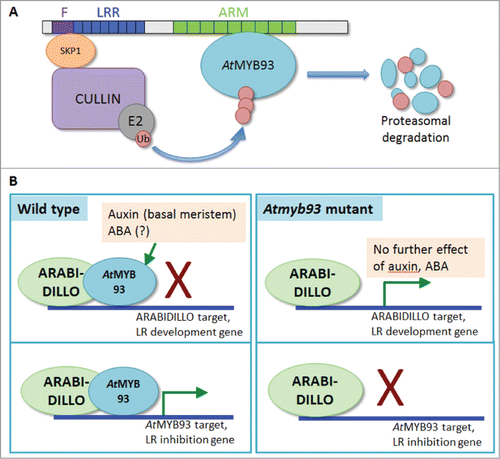Figures & data
Figure 1. The endodermis and its role in lateral root regulation. (A) An Arabidopsis seedling (left) showing magnification of a confocal section of the root tip (right) with the endodermal cell layer highlighted in green and the pericycle, from which lateral roots arise, in blue. The genes, phytohormones and environmental/stress signals currently known to impinge on the endodermis during lateral root development are shown. ABA, abscisic acid; SLs, strigolactones. (B) Confocal section of an Arabidopsis root showing a developing lateral root primordium (arrow) with expression of pAtMYB93::GUS (green) immediately adjacent to the primordium in the overlying endodermal cell (arrowhead). Image courtesy of George Bassel.

Figure 2. Potential models for AtMYB93 activity and its interaction with ARABIDILLOs. (A) Model for ARABIDILLO-AtMYB93 interaction based on the hypothesis that ARABIDILLOs act as F-box components of an SCF E3 ligase complex during LR development. In this scenario, ARABIDILLOs would ubiquitinate AtMYB93, an inhibitor of LR development. This would promote AtMYB93 degradation by the proteasome and promote LR formation. An arabidillo mutant would accumulate AtMYB93 protein, and hence have fewer LRs, as has been reported (Coates et al., 2006). F, F-box; LRR, Leucine-Rich Repeats; ARM, Armadillo repeats; Ub, ubiquitin. (B) Model for the ARABIDILLO-AtMYB93 interaction based on their action as a bipartite transcription factor, supported by data in Gibbs et al., (2014). Top left: AtMYB93 could act as an inhibitor of LR development genes, blocking a positive action of ARABIDILLO. Auxin and ABA increase AtMYB93 transcript levels. Top right: in the Atmyb93 mutant, absence of AtMYB93 would allow ARABIDILLO to activate LR development genes, and auxin and ABA would have no further effect. Bottom left: in this scenario, AtMYB93 activates genes that inhibit LR development, acting as part of a bipartite transcription factor withARABIDILLO. Bottom right: In the Atmyb93 mutant, ARABIDILLO cannot function by itself, so no LR inhibition genes are activated.

